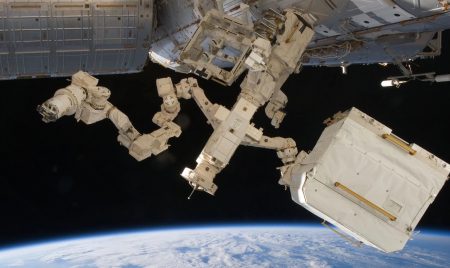
April 27, 2019 – The Defense Research arm of the United States military is looking to remotely repair the more than 400 military, government, and commercial satellites currently in geosynchronous orbit about the Earth. Among these satellites are those providing telecommunications, weather predictions, and remote surveillance, which makes all mission-critical systems that would take years to replace should something go wrong.
That’s why DARPA (the Defense Advanced Research Projects Agency) has launched a search for a partner to build a new type of robotic satellite to freely roam 35,000 kilometers (22,000 miles) above the Earth and provide repair services as needed to existing and future geosynchronous satellites.
The current generation of satellites operating at these heights have built-in multiple redundancies should something fail. That makes them heavy to launch and expensive to build. When malfunctions occur they are designed to use onboard backup systems while ground crews try to do remote diagnostics.
That’s why a roving repair robot in deeper space would be such an important asset. And once built and successfully demonstrated it would mean any future geosynchronous satellites would not have to be designed with as much redundancy, and weight, saving a considerable amount of money.
The DARPA initiative has been named the Robotic Servicing of Geosynchronous Satellites (RSGS) Program, and a proposer’s day is planned for Washington this May.
Having reviewed the DARPA documentation it is clear that what is being envisaged is a dexterous robotic system capable of operating in geosynchronous space to repair current U.S. satellites with the ultimate goal to help transform the architecture of future satellites. The initial project will require the DARPA partner to build the satellite, and both launch and operate it. DARPA would help with software and hardware development, testing, and integration of the advanced robotics payload to create an efficient form factor. DARPA would also assist in the development of key software and robotics workstations for mission operations, and assist with payload integration for launch. And finally, DARPA would develop training and mission support.
The DARPA program is a logical next step in the development of space infrastructure. When you consider the cost of two Space Shuttle missions, at $400 million each, launched to repair and upgrade the $4.7 billion Hubble Space Telescope you can see why a more economical way to handle satellite repair is needed. Hubble does not orbit at geosynchronous heights and yet the missions flown were logistically challenging and expensive. A robotic alternative would have provided a much more budget conscious way to ensure the continuity of the space telescope. Now DARPA wants to do what was done with Hubble using robots, and do it to satellites in geosynchronous orbit, a very remote and tall order.
There is already an existing repair robot in space on the International Space Station (ISS). It is Dextre, the Canadian Space Agency’s handyman which is being used for doing ISS outside repairs. Dextre requires human operators on the ISS or at ground stations to control its tasks. It is not autonomous which may be the way a future robotic repair spacecraft will operate to service malfunctioning satellites in deeper space.









